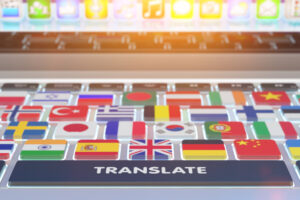Note: This blog post was originally written in Japanese for our Japanese website. We used our machine translation platform Translation Designer to translate it and post-edit the content in English. The original Japanese post can be found here.
It is said that Google Translate has greatly improved its accuracy. Google Translate, also known as Neural Machine Translation (NMT), is expected to continue to take the lead in the machine translation market. Back translating the Google translation results may not be so funny anymore!
So, what exactly is neural translation?
Neural translation is a translation method that utilizes a neural network. A neural network is artificial intelligence (AI), a mechanism similar to the nerve cells of the human brain and uses a simplified activity model of the brain’s nerve cells. The machine simulates the activity of the human brain when a person memorizes something and creates AI. This technology is also called deep learning because it analyzes each matter step by step.
Research on neural network has been carried out for about 50 years, but a very large amount of data is needed to gain highly accurate results. Back then, there was not enough data, and computers did not have the capability to handle such a large amount of information. By entering the digital age, this problem has been solved all at once.
Especially for neural network, where the amount of data speaks the loudest, Google stands in an advantageous position since it is able to collect a huge amount of data. It also has great advantage in terms of their staff who are excellent talents gathered from all over the world and are capable of handling the data efficiently.
Neural network may not sound familiar to you, but it is also used to identify spam emails in our inbox.
Before, the definition of spam email was manually given to the machine to identify it as spam. The majority of this operation was done by hand. Now, the neural network is used to determine spam, and the computer itself learns the characteristics of spam email from a massive amount of data. Therefore, users only need to check whether the emails, which are already judged as spam, are actually spam. As a result, spam emails can now be identified with 99.9% accuracy.
Text in images can now also be translated!
Google Photo provided by Google is also one of the accomplishments of machine learning through the neural network. It can identify and distinguish an object from the image. The service provides a function where it identifies people, animals, scenery such as the ocean and sky, etc., and automatically creates an album by each category.
Neural translation utilized this technology. For example, translating text in images was said to be difficult. However, this technology has now made it possible! In addition, conventional machine translation used to translate by small sections, but with neural translation, it can find translation options by sentences. Now that it is capable of adjusting the order of the words, it is able to achieve translations closer to human translation.
In November 2016, Google expanded the target languages for neural translation to eight languages combined with English: French, German, Spanish, Portuguese, Chinese, Korean, Japanese, and Turkish. These eight languages together are said to be equivalent to the languages spoken by one-third of the world's population, and it is becoming more and more practical.
With the arrival of the digital age, businesses have no choice but to adopt machine translation using neural translation. This is because they are required to deliver many translated documents in a short period of time since the scope of translations have expanded.
Neural translation is now practical. Will human translation survive?
By using machine translation, it will be possible to reduce the effort to translate, by half or less. Meanwhile, there is also a growing debate that machine translation will eliminate the need for translators. However, it is still difficult to entirely switch to machine translation.
Neural translation is on a practical level, and it is possible for machine translation to translate a language into multiple languages. However, post-editing by a human is essential to create translations that do not cause misunderstandings between languages with different cultural backgrounds. Therefore, post-editing work may increase from now on.
On the other hand, the development of neural translation can support you through translating contents you have not tried before. It might give you time to tackle another task while the machine translation does the rough draft for you. If you can get along well with machine translation, you may be able to take in more tasks with better productivity.
Kawamura's machine translation services
Kawamura International has been working with machine translation for over 20 years of trial and error.
If you are considering using machine translation and wish to compare services, we can propose an engine that meets your company's requirements. We can advise you on how to select the right engine, such as connections with your CAT tool and comparing the specifications. Please feel free to contact us!
_CMYK_OL.png)

